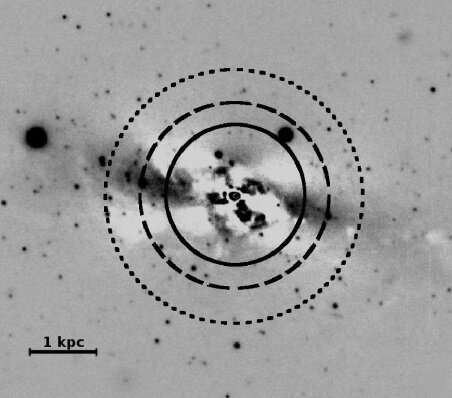February 17, 2020 report
Globular cluster system of NGC 4546 studied in detail

Using the Gemini-South telescope, astronomers have performed a photometric study of the lenticular galaxy NGC 4546. Results of the new research provide more clues about the structure and nature of the galaxy's globular cluster system. The study was published February 7 on arXiv.org.
Globular clusters (GCs) are collections of tightly bound stars orbiting galaxies. Astronomers perceive them as natural laboratories enabling studies on the evolution of stars and galaxies. In particular, globular clusters could help researchers to better understand the formation history and evolution of early-type galaxies as the origin of GCs seems to be closely linked to periods of intense star formation.
Located some 45.6 million light years away, NGC 4546 is a nearly edge-on, lenticular (S0) galaxy with a stellar mass of about 27 billion solar masses. So far, only one study of its globular cluster system has been conducted, in 2015, which estimated the total population of this system within 163,000 light years as 120 members.
In order to get a more detailed view of the GC system of NGC 4546, a group of astronomers led by Carlos Escudero of National University of La Plata, Argentina, carried out photometric observations of this galaxy. For this purpose, they employed the GMOS camera on the Gemini-South telescope in Chile.
"In this work, we present the analysis of the global properties of the GC system associated with the S0 galaxy NGC 4546, using Gemini/GMOS data of three fields in the g′r′i′z′ filters," the astronomers wrote in the paper.
The study measured the photometry of 350 GC candidates in NGC 4546 by obtaining the integrated color distributions, their density profiles and azimuthal distributions. In result of the observations, the total population of GCs was estimated to be about 390, assuming that a maximum length of the GC system of this galaxy is 163,000 light years. The specific frequency, defined as the total number of GCs per unit host galaxy luminosity, was found to be at a level of approximately 3.3.
The astronomers underlined that the estimated number of 390 GCs is significantly higher than the value estimated in 2015, and it corresponds to a relatively high specific frequency for galaxies with similar masses and environment.
The research also found extensive irregular regions of dust extending about 19,500 light years along the semimajor axis of NGC 4546. According to the authors of the paper, this finding, together with the presence of a disk of gas rotating in the opposite direction to the stellar component of the galaxy, deliver interesting information about the history of NGC 4546. The astronomers suppose that such structures are indicative of a merger or interaction event in the recent past with an object of lower mass than NGC 4546.
"We suggest that the unusual GC population substructures were possibly formed during the interaction that led to the formation of the young ultra-compact dwarf (NGC 4546-UCD1) found in this system," the astronomers concluded.
The scientists noted that this object, designated NGC 4546-UCD1, would have an age below four billion years and rotation direction similar to the gas distribution. However, they do not exclude the possibility of an interaction with a small companion lenticular galaxy, known as CGCG 014-074, which is located at a projected distance of approximately 71,700 light years away from NGC 4546.
More information: Field/Isolated lenticular galaxies with high SN values: the case of NGC 4546 and its globular cluster system, arXiv:2002.02765 [astro-ph.GA] arxiv.org/abs/2002.02765
© 2020 Science X Network





















